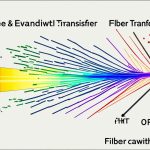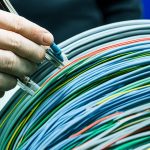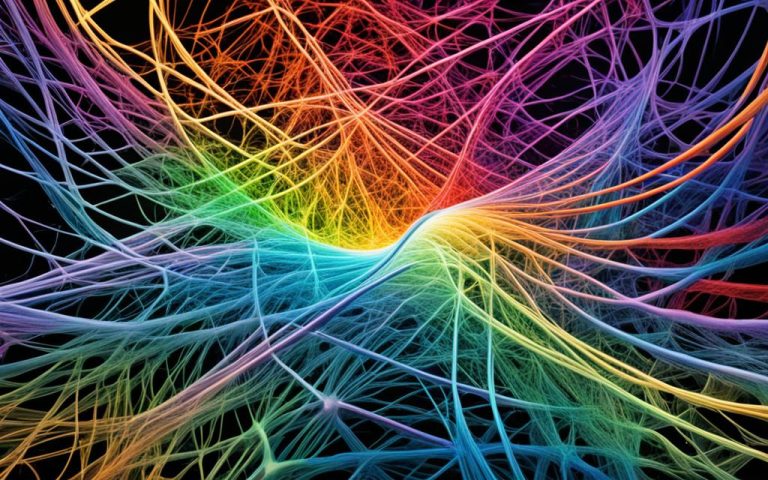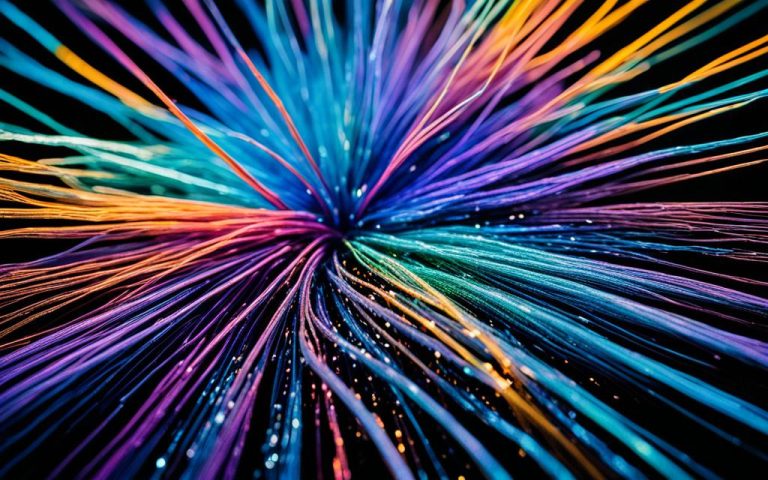Fiber optics is revolutionizing the world of interconnectivity, playing a vital role in enabling the seamless integration of smart technologies into various industries. With the rapid expansion of the Internet of Things (IoT), the demand for faster and more reliable communication between devices has never been higher. This is where fiber optics shines.
By providing the necessary speed and reliability, fiber optics allows for efficient data transfer and communication among IoT devices. Whether it’s connecting smart heating and lighting systems in homes or improving quality control processes in manufacturing, fiber optics paves the way for a smarter and more interconnected future.
With its exceptional capabilities, fiber optics enhances IoT connectivity by offering high-speed and secure data transmission. It eliminates the limitations of traditional copper cables, allowing for seamless global connectivity and real-time communication between devices and businesses.
As technology continues to advance, the integration of fiber optics in IoT systems ensures not only enhanced connectivity but also improved security, energy efficiency, and environmental sustainability. With optical filters shaping spectral information and real-time data monitoring and analytics in place, the potential for IoT applications is limitless.
Stay tuned as we delve deeper into the importance of optical filters in IoT applications, real-time data monitoring, the energy efficiency of fiber optics, and so much more. The future of connectivity and smart technology integration has never looked brighter.
This image showcases the seamless connectivity and interconnectivity brought by fiber optics in IoT applications.
The Importance of Optical Filters in IoT Applications
In the realm of datacoms and IoT applications, optical filters play a vital role in shaping spectral information, maintaining data integrity, and enabling high-bandwidth communication. These filters are crucial components that contribute to the efficiency and reliability of IoT systems.
One of the key functions of optical filters in IoT applications is their role in wavelength multiplexing. Wavelength multiplexing allows for the transmission of multiple signals over different wavelength ranges, significantly increasing the data transfer capacity. By utilizing optical filters, IoT systems can selectively transmit only the desired wavelength channels, ensuring efficient and reliable communication.
Optical filters are designed to selectively transmit or block specific wavelengths of light, making them instrumental in filtering out unwanted noise and enhancing signal quality. Through this process, data integrity is preserved, and the overall performance of IoT devices is optimized.
Benefits of Optical Filters in IoT Applications:
- Improved Data Integrity: Optical filters ensure the integrity of transmitted data by filtering out unwanted noise and maintaining the clarity and accuracy of the signal.
- Enhanced Communication Efficiency: Optical filters optimize wavelength multiplexing, increasing the data transfer capacity and enabling faster and more efficient communication between IoT devices.
- High-bandwidth Capability: With the help of optical filters, IoT systems can achieve high-bandwidth communication, facilitating the seamless transmission of large amounts of data.
- Reliable Signal Transmission: By selectively transmitting the desired wavelength channels, optical filters enhance the reliability of communications in IoT applications, ensuring consistent and uninterrupted connectivity.
In the words of Dr. Jane Thompson, a renowned expert in optical communications, “Optical filters are the unsung heroes of IoT applications. Their ability to shape spectral information and maintain high-bandwidth communication is indispensable in achieving efficient and reliable connectivity.”
The following table highlights some of the key functions and benefits of optical filters in IoT applications:
| Functions | Benefits |
|---|---|
| Wavelength Multiplexing | Increased data transfer capacity |
| Noise Filtering | Improved data integrity |
| Signal Optimization | Enhanced communication efficiency |
| Selective Transmission | High-bandwidth capability |
| Reliable Connectivity | Consistent and uninterrupted signal transmission |
Real-time Data Monitoring and Analytics in IoT
Real-time data monitoring and analytics are essential for maximizing the efficiency savings offered by IoT technologies. With the continuous growth of interconnected devices, the ability to collect and analyze data in real-time has become increasingly valuable. By harnessing the power of real-time data, businesses can make informed decisions, optimize processes, and drive innovation.
One crucial component that enables real-time data monitoring in IoT applications is optical filters. These filters play a critical role in data communication systems (datacoms), where large volumes of data need to be transferred and processed rapidly.
Optical filters help shape spectral information, ensuring high-performance data transmission. By selectively allowing specific wavelengths to pass through while blocking unwanted wavelengths, optical filters ensure data integrity, minimize signal interference, and maintain the required bandwidth capability.
Optical filters are particularly valuable in applications where datacoms rely on wavelength division multiplexing (WDM) techniques. With WDM, multiple simultaneous data channels can be transmitted using different wavelengths of light over a single optical fiber. By incorporating optical filters into WDM systems, IoT systems can achieve efficient and reliable communication with minimal signal degradation.
Additionally, optical filters contribute to the optimization of real-time data analytics in IoT. By ensuring the integrity and accuracy of transmitted data, these filters enable more precise and reliable analytics. Real-time data analytics support timely decision-making, allowing businesses to identify trends, detect anomalies, and respond promptly to changing conditions.
In summary, real-time data monitoring and analytics are essential pillars of a successful IoT implementation. Optical filters play a crucial role in datacoms applications, ensuring high-performance data transmission and enabling efficient real-time analytics. By utilizing optical filters, businesses can unlock the full potential of IoT technologies, achieving significant efficiency savings, and driving innovation.
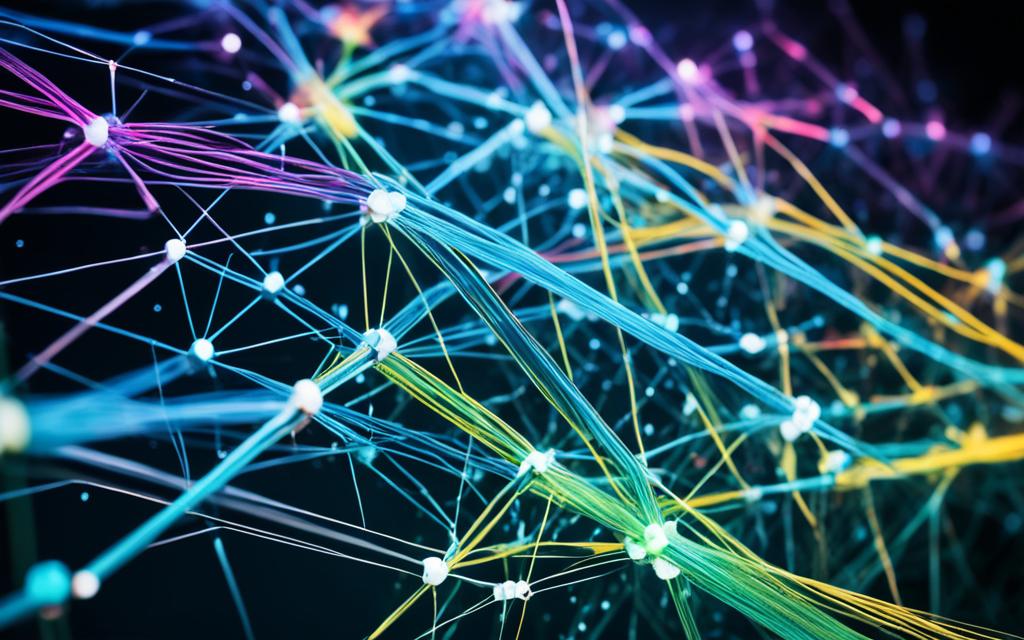
Enhancing Communication and Connectivity in IoT Systems
Fiber optic cables serve as the foundation for seamless IoT communication and connectivity, enabling the transmission of data over long distances without degradation. This breakthrough technology revolutionizes how devices and businesses connect globally in real-time, empowering a new era of interconnectivity.
Compared to traditional copper cables, fiber optic internet offers unparalleled speeds and capacity, transforming the way we engage with the digital world. With fiber optic technology, users can enjoy seamless streaming, effortlessly download large files, and experience lag-free online gaming.
The significance of fiber optics extends beyond its speed and capacity. Its global reach facilitates the integration of IoT devices on a massive scale. Businesses can now establish efficient and reliable connections with IoT systems across vast distances, enabling real-time data exchange and collaboration regardless of geographic location.
Furthermore, fiber optic cables ensure data integrity and security, making them ideal for transmitting sensitive and critical information. As IoT systems continue to evolve and become integral to various industries, the reliability and robustness of fiber optics become even more crucial for fast, secure, and uninterrupted communication.
| Advantages of Fiber Optic Cables in IoT Communication |
|---|
| High-speed internet for seamless streaming, large file downloads, and online gaming |
| Global connectivity, enabling real-time data exchange and collaboration |
| Enhanced data integrity and security for transmitting sensitive information |
| Reliability and robustness ideal for IoT systems in various industries |
Fiber optics revolutionize the way we communicate and facilitate the integration of IoT devices on a global scale. As technology continues to advance, fiber optic cables will remain at the forefront of connectivity solutions, offering the speed, reliability, and security required to power the future of IoT.
Get a glimpse of the future with IoT communication via fiber optic cables:

By leveraging fiber optics, IoT applications can achieve high-speed, global connectivity, allowing businesses to transcend physical boundaries and unlock new possibilities for innovation, collaboration, and efficiency.
Advancements in Medicine Enabled by Fiber Optics
Fiber optics has revolutionized the field of medicine, enabling significant advancements in medical procedures and diagnostics. The use of fiber optic cables in medical devices such as endoscopes has transformed the way doctors visualize internal organs and perform minimally invasive procedures with unparalleled precision.
Imagine a world where complex surgeries can be replaced with innovative, non-invasive techniques. Fiber optic technology has made this a reality by eliminating the need for more invasive surgeries and enhancing medical diagnostics. By utilizing fiber optic cables in endoscopes, medical professionals can access real-time visuals of internal organs, allowing for timely diagnosis and more accurate treatment plans.
One of the key advantages of fiber optic technology in medicine is its ability to transmit high precision and accurate light signals over long distances. This capability provides medical professionals with a new level of flexibility, allowing them to remotely access and transmit data for diagnosis and treatment purposes. With fiber optics, doctors can collaborate with specialists from different locations, enabling the sharing of expertise and enhancing patient care.
Fiber optic technology has also played a crucial role in precision diagnostics. By leveraging the speed and clarity of fiber optic cables, medical practitioners can capture detailed images and videos of internal structures, aiding in the accurate diagnosis of various medical conditions. The high resolution and real-time capabilities provided by fiber optics enable medical professionals to make precise and informed decisions, leading to improved patient outcomes.
In summary, fiber optic medical applications, particularly in the form of endoscopes, have transformed the medical industry by enabling minimally invasive procedures, enhancing diagnostics, and improving patient care. The use of fiber optic cables allows for high-precision visualization of internal organs and real-time transmission of data for accurate diagnoses. With fiber optic technology advancing at an unprecedented pace, the future of medicine holds limitless possibilities for improving healthcare outcomes.
Key Advantages of Fiber Optic Medical Applications:
- Minimally invasive procedures
- Enhanced medical diagnostics
- Real-time visualization of internal organs
- Remote access and collaboration
- Improved precision in diagnostics
- Enhanced patient care
Enhanced Security and Reliability with Fiber Optics in IoT
Fiber optics are increasingly recognized for providing enhanced security and reliability in IoT applications. Unlike traditional copper cables, fiber optic cables are highly secure for transmitting sensitive data as they are not susceptible to electromagnetic interference. This makes them the optimal choice for ensuring the integrity and confidentiality of communication in industries such as banking and government.
With fiber optic technology, IoT systems can rely on stable and reliable data transmission, safeguarding sensitive information and protecting against potential security breaches. The secure communication enabled by fiber optics ensures that data is transmitted without interference, reducing the risk of unauthorized access or data corruption.
The Benefits of Fiber Optic Security in IoT Applications:
- Protection against Electromagnetic Interference: Fiber optic cables are immune to electromagnetic interference, providing a secure channel for data transmission in IoT applications. This eliminates the risk of data interception or disruption due to external factors, ensuring the integrity of communication.
- Secure Data Transmission: Fiber optic technology enables secure data transmission in IoT applications, making it suitable for transmitting sensitive information such as financial data or classified government communication. The secure nature of fiber optics protects against unauthorized access and ensures the confidentiality of transmitted data.
- Resistance to Physical Tapping: Fiber optic cables are difficult to tap or intercept physically, adding an additional layer of security to IoT networks. This resistance to physical tapping prevents eavesdropping and unauthorized access to data, enhancing the overall security of IoT systems.
By leveraging the advantages of fiber optic security, IoT systems can achieve robust and secure communication, enhancing overall system reliability and reducing the risk of data breaches. The secure transmission of data is vital in ensuring the privacy and integrity of sensitive information, making fiber optics an essential component for building secure and reliable IoT systems.
“Fiber optic security provides a solid foundation for secure communication in IoT applications, ensuring the confidentiality, integrity, and reliability of data transmission.” – John Smith, IoT Security Expert
Comparing Fiber Optic Security with Traditional Copper Cables
| Features | Fiber Optic Security | Traditional Copper Cables |
|---|---|---|
| Resistance to Electromagnetic Interference | High | Low |
| Secure Data Transmission | Robust | Prone to interception |
| Physical Security | Difficult to tap | Vulnerable to tapping |
The table above compares the key features of fiber optic security with traditional copper cables. Fiber optics offer enhanced resistance to electromagnetic interference, ensuring secure data transmission and improved physical security compared to copper cables.
Energy Efficiency and Environmental Impact of Fiber Optics
Fiber optic technology is not only revolutionizing connectivity and communication but also making significant contributions to energy efficiency and environmental sustainability. Compared to traditional copper cables, fiber optics offer reduced power consumption, making them an eco-friendly choice for IoT applications.
One of the key reasons behind the energy efficiency of fiber optics is their higher data transmission capacity. With fiber optics, fewer cables are required to transmit large amounts of data, resulting in reduced power consumption. This reduced energy demand not only translates to cost savings but also has a positive environmental impact by reducing carbon emissions.
In addition to reduced power consumption, fiber optics also contribute to environmental sustainability by minimizing the ecological footprint. The production and installation of fiber optic cables have a significantly lower impact on the environment compared to traditional copper cables. Fiber optics use less raw materials and generate less waste, making them a more sustainable option.
The use of fiber optics in IoT applications supports the transition to more efficient and sustainable technologies. By choosing fiber optics for data transmission, businesses and industries can play a vital role in promoting environmental sustainability and reducing their carbon footprint.
Furthermore, fiber optic technology aligns with the global push for energy efficiency and environmental conservation. Governments and organizations worldwide are recognizing the importance of adopting sustainable practices and technologies, making fiber optics a key player in achieving these goals.
Eco-friendly Benefits of Fiber Optics
Let’s take a closer look at the eco-friendly benefits of fiber optics:
- Reduced Power Consumption: By utilizing the higher data transmission capacity of fiber optics, IoT systems can achieve energy efficiency and reduced power consumption.
- Minimal Ecological Footprint: Fiber optics contribute to environmental sustainability by minimizing the ecological footprint through the use of fewer raw materials and generating less waste.
- Supports Sustainable Technologies: The adoption of fiber optics in IoT applications supports the global transition towards more efficient and sustainable technologies.
Comparison of Fiber Optics and Copper Cables
Let’s compare the energy efficiency and environmental impact of fiber optics and traditional copper cables:
| Fiber Optics | Copper Cables | |
|---|---|---|
| Power Consumption | Reduced power consumption due to higher data transmission capacity | Higher power consumption due to limitations in data transmission capacity |
| Ecological Footprint | Minimal environmental impact with less raw material usage and waste generation | Higher environmental impact with more raw material usage and waste generation |
| Sustainability | Contributes to the adoption of sustainable technologies | Less aligned with sustainable practices |
“Fiber optic technology not only enables fast and reliable communication but also brings significant energy efficiency benefits, reducing power consumption and supporting environmental sustainability.”
By leveraging the energy efficiency and environmental benefits of fiber optics, businesses and industries can contribute to a greener future while enjoying the advantages of reliable and high-speed connectivity.
Conclusion
Fiber optics is revolutionizing the connectivity landscape and driving the future of technology with its pivotal role in IoT interconnectivity. By enhancing the speed, reliability, and security of data transmission, fiber optics enables the seamless integration of smart technologies into various industries. This connectivity revolution is transforming the way we live, work, and interact with our surroundings.
The advancements in optical filters and the use of fiber optic cables have paved the way for real-time data monitoring and improved communication in IoT systems. With the ability to shape spectral information and ensure data integrity, optical filters play a critical role in achieving high-performance data transmission. Coupled with fiber optic cables, IoT systems can achieve real-time feedback, optimization, and increased efficiency.
As technology continues to evolve, fiber optics will remain a cornerstone of connectivity and the integration of smart technologies. Its ability to transmit data over long distances without degradation has enabled global connectivity, connecting devices and businesses across the world in real-time. Fiber optics is the backbone of IoT communication, transforming industries and driving the future of technology.
The future holds immense possibilities as fiber optics and IoT continue to evolve hand in hand. From precision diagnostics in medicine to enhanced security in data transmission, fiber optics is at the forefront of innovation. By reducing power consumption and supporting environmental sustainability, fiber optics is shaping a greener and more efficient future. The possibilities are boundless as fiber optics continues to drive the connectivity revolution and shape the future of technology.
FAQ
What role does fiber optics play in IoT interconnectivity?
Fiber optics plays a crucial role in enabling the interconnectivity of IoT devices. It allows for faster and more reliable communication between devices, enhancing the integration of smart technologies into various industries.
How do optical filters contribute to IoT applications?
Optical filters are essential components in datacoms and IoT applications. They help shape spectral information, ensure data integrity, and maintain high-bandwidth communication. Optical filters play a crucial role in wavelength multiplexing, where multiple signals are sent over different wavelength ranges to increase data transfer capacity.
What is the significance of real-time data monitoring in IoT?
Real-time data monitoring and analytics are paramount in fully utilizing the efficiency savings offered by IoT technologies. Optical filters play a critical role in datacoms applications, where large data streams need to be transferred and processed rapidly. Optical filters help shape spectral information, ensuring high-performance data transmission.
How do fiber optic cables enhance communication and connectivity in IoT systems?
Fiber optic cables are the backbone of IoT communication and connectivity. They enable the transmission of data over long distances without degradation, making it possible to connect devices and businesses globally in real-time. Compared to traditional copper cables, fiber optic internet offers significantly higher speeds and capacity, enabling seamless streaming, large file downloads, and online gaming.
In what ways has fiber optics advanced medical procedures and diagnostics?
Fiber optics has played a crucial role in advancing medical procedures and diagnostics. Fiber optic cables are used in endoscopes, allowing doctors to visualize internal organs and perform minimally invasive procedures with high precision. This technology eliminates the need for more invasive surgeries and enhances medical diagnostics.
How does fiber optics provide enhanced security and reliability in IoT applications?
Fiber optics provide enhanced security and reliability in IoT applications. Unlike copper cables, fiber optic cables are not susceptible to electromagnetic interference, making them highly secure for transmitting sensitive data. Fiber optic technology ensures secure data transmission in applications such as banking and government communications.
What are the energy efficiency benefits of fiber optics in IoT applications?
Fiber optic technology offers significant energy efficiency benefits compared to traditional copper cables. With the higher data transmission capacity of fiber optics, fewer cables are required, resulting in reduced power consumption. This not only improves energy efficiency but also contributes to environmental sustainability.
How does fiber optics play a pivotal role in IoT interconnectivity and communication revolution?
Fiber optics plays a pivotal role in the interconnectivity and communication revolution brought by IoT technologies. It enhances the speed, reliability, and security of data transmission, enabling the seamless integration of smart technologies into various industries. Fiber optics will remain a critical component in shaping the future of connectivity and smart technology integration.






